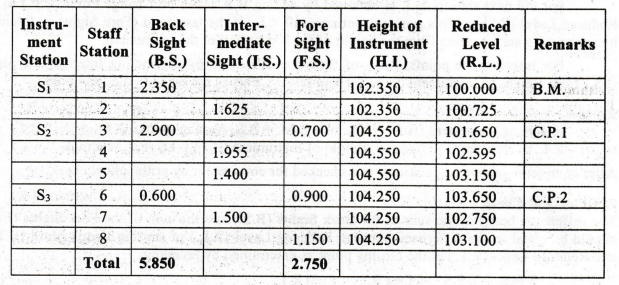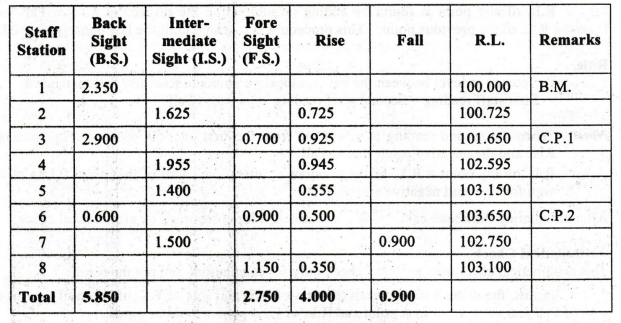Basic Civil & Mechanical Engineering: UNIT II: d. Levelling
Methods of reduction of levels
Levelling | Surveying
METHOD 1 - HEIGHT OF COLLIMATION METHOD or HEIGHT OF INSTRUMENT METHOD, 2. METHOD 2: RISE AND FALL METHOD3. EXERCISES4. COMPARISON OF HEIGHT OF COLLIMATION METHOD WITH RISE AND FALL METHOD
METHODS OF REDUCTION OF LEVELS
1. METHOD 1 - HEIGHT OF COLLIMATION METHOD or HEIGHT OF INSTRUMENT METHOD
In
this method, Height of the Instrument (H.I.) is calculated for each setting of
the instrument by adding Back Sight (B.S.) to elevation of Bench Mark (B.M.).
Reduced level of Change Point (C.P.) is then calculated by subtracting Fore
Sight (F.S.) from H.I.
For
the next setting, H.I. is obtained by adding B.S, taken on Change Point (C.P.)
to its Reduced Level (R.L.). This process continues till R.L. of the last point
(Fore Sight) is obtained by subtracting staff reading from the height of the
last setting of the instrument.
ediate
points, R.L.s of them are calculated by subtracting Intermediate Sight (I.S.)
from Height of Instrument (H.I.) for that setting. Entries are made in the
field book.
Rules
Height
of Instrument (H.I.) = R.L. of a B.M. + B.S. reading on that B.M.
R.L.
of other staff stations = Height of Instrument (H.I.) – I.S./F.S. readings
After
completing above calculations, it is checked for correctness by arithmetical
check.
Arithmetical
Check
The
difference between the sum of the Back Sights (B.S.) and the sum of the Fore
Sights (F.S.) should be equal to the difference between Reduced Level (R.L.) of
starting Bench Mark (B.M.) and Reduced Level (R.L.) of the closing point as
determined by levelling.
E
B.S. ~ F.S. = Last R.L. ~ First R.L.
Note:
This check verifies only the calculation of R.L. and not the correctness of
R.L. This also offers a check for Height of Instrument (H.I.) and R.L.s of Back
Sight (B.S.) and Fore Sight (F.S.). The arithmetic check does not involve
Intermediate Sights (I.S.).
PROBLEM
2:
The
following staff readings were observed successively with a level, the instrument
having been moved after third and seventh readings:
2.350,
1.625, 0.700, 2.900, 1.955, 1.400, 0.900, 0.600, 1.500, 1.150
Enter
the above readings in a page of a field level book. Calculate the R.L.s of all
the points by Height of Collimation Method. The first reading was taken with a
staff held on a Bench Mark of R.L. 100.000 m. Apply arithmetical check.
Solution
The
instrument was shifted after third and seventh readings. Hence, these readings
will be entered in the Fore Sight (F.S:) column. Also, the fourth and eighth
readings will be entered in the Back Sight (B.S.) column.
Further,
the first reading will be entered in Back Sight (B.S.) column and the last
reading in Fore Sight (F.S.) column. All other readings will be entered in the
Intermediate Sight (I.S.) column.
Rules:
In
the Height of Instrument Method or Height of Collimation Method,
Height
of Instrument (H.I.) = R.L. of B.M. + B.S. on that B.M. R.L. of any point =
Height
of Instrument (H.I.) – I.S. /F.S. of that point
Instrument
Setup S1
Height
of Instrument (H.I.) at Sy = 100+ 2.350 = 102.350
R.L.
of intermediate point 2 = H.I. at Si - I.S. / F.S. at 2 = 102.350 – 1.625 =
100.725
R.L.
of intermediate point 3 = H.I. at Sı- I.S. / F.S. at 3 = 102.350 - 0.700 =
101.650

Instrument
Setup S2
Height
of Instrument (H.I.) at S2 = R.L. of point 3+ B.S. = 101.650 + 2.900
= 104.550
R.L.
of intermediate point 4 = H.I. at S2 - I.S. at 4 = 104.550 - 1.955 =
102.955
R.L.
of intermediate point 5 = H.I. at S2 - I.S. at 5 = 104.550 – 1.400 =
103.150
R.L.
of intermediate point 6 = H.I. at S2 - I.S. at 6 = 104.550 - 0.900 =
103.650
Instrument
Setup S3
Height
of Instrument (H.I.) at Sz = R.L. of point 6 + B.S. = 103.650 + 0.600 = 104.250
R.L. of intermediate point 7 = H.I. at S3 - I.S. at 7 = 104.250 – 1.500 =
102.750 R.L. of intermediate point 8 = H.I. at S3 - I.S. at 8 = 104.250 - 1.150
= 103.100
Arithmetical
Check
∑B.S.
- ∑ F.S. = Last R.L. - First R.L.
5.850
– 2.750 = 103.100 - 100.000 = 3.100. Hence
checked.
2. METHOD 2: RISE AND FALL METHOD
In
this method, the difference of level between the two consecutive points is
obtained by comparing the staff readings taken from the same setup of the
instrument. This difference indicates whether next point is at Rise or Fall
than the previous one. If staff reading is greater, the point is at Fall. If
staff reading is smaller, the point is at Rise.
R.L.
of any point is found by adding or subtracting the respective Rise or Fall
values from the R.L. of the previous point. This procedure is repeated until
the last point is reached.
Rule
Difference
in level between the two consecutive points in Rise and Fall method is: = First
staff reading - Second staff reading = ± Rise / Fall
Note:
When the second reading is subtracted from the first one, the positive result
means the Rise and the negative result means Fall.
R.L.
of any point = R.L. of the previous point = Rise / Fall of that point. Use
positive sign for Rise and negative sign for Fall.
After
completing the above calculations, it is checked for correctness by
arithmetical check.
Arithmetical
Check
This
arithmetical check also provides check only for calculations and not the
result.
In
this, the differences between the sum of B.S. and sum of F.S., the sum of Rise
and the sum of Fall and the R.L. of Last point and R.L. of First point should
be equal.
∑
B.S. ~ ∑ F.S. = ∑ Rise ~ Fall = Last R.L. ~ First R.L.
[That
is, ∑ B.S - ∑ F.S = ∑ Rise - ∑ Fall = Last R.L. – First R.L. or
∑
F.S. - ∑ B.S = ∑ Fall - ∑ Rise = First R.L. - Last R.L.]
This
method provides a complete check on the Intermediate Sight (I.S.) also, since
all the sights are covered in the arithmetic check.
PROBLEM
3:
Solve Problem 2 by Rise and Fall Method.
The
following staff readings were observed successively with a level, the
instrument having been moved after third and seventh readings.
2.350,
1.625, 0.700, 2.900, 1.955, 1.400, 0.900, 0.600, 1.500, 1.150
Enter
the above readings in a page of a field level book. Calculate the R.L.s of all
the points by Rise and Fall Method. The first reading was taken with a staff
held on a Bench Mark of R.L. 100.000 m. Apply arithmetical check.
Solution
The
instrument was shifted after third and seventh readings. Hence, these readings
will be entered in the Fore Sight (F.S.) column. Also, the fourth and eighth
readings will be entered in the Back Sight (B.S.) column.
Further,
the first reading will be entered in the Back Sight (B.S.) column and the last
reading in the Fore Sight (F.S.) column. All other readings will be entered in
the Intermediate Sight (I.S.) column.

Calculation
of Rise and Fall of Points
Compare
B.S. of 1 and F.S. of 2 (Reading on 1 is greater, therefore Rise from 1 - 2)
Difference
in levels between staff stations 1 -2 = 2.350 – 1.625 = 0.725 (Rise)
Difference
in levels between staff stations 2-3 = 1.625 - 0.700 = 0.925 (Rise)
Difference
in levels between staff stations 3-4 = 2.900 - 1.955 = 0.945 (Rise)
Difference
in levels between staff stations 4 - 5 = 1.955 – 1.400 = 0.555 (Rise)
Difference
in levels between staff stations 5 - 6 = 1:400 - 0.900 = 0.500 (Rise)
Difference
in levels between staff stations 6 - 7 = 0.600 – 1.500 = -0.900 (Fall)
Difference
in levels between staff stations 7-8 = 1.500 - 1.150 = 0.350 (Rise)
Calculation
of R.L. of Points
R.L.
of a point = [R.L. of preceding point + Rise] or [R.L. of preceding point -
Fall]
R.L.
of station 1 is B.M. = 100.000
R.L.
of station 2 = 100.000 + 0.725 = 100.725
R.L.
of station 3 = 100.725 + 0.925 = 101.650
R.L.
of station 4 = 101.650 + 0.945 = 102.595
R.L.
of station 5 = 102.595 +0.555 = 103.150
R.L.
of station 6 = 103.150 + 0.500 = 103.650
R.L.
of station 7 = 103.650 - 0.900 = 102.750
R.L.
of station 8 = 102.750 +0.350 = 103.100
Arithmetical
Check
∑
B.S. - ∑ F.S. = ∑ Rise - ∑ Fall = Last R.L. - First R.L.
5.850
-2.750 = 4.000 - 0.900 = 103.100 - 100.000
3.100
= 3.100 = .. 3.100
Hence
checked.
3. EXERCISES
PROBLEM
4:
The following staff readings were observed successively with a level:
0.875,
1.235, 2.310, 1.385, 2.930, 3.125, 4.125, 0.120, 1.875, 2.030, 2.765
The
first reading was taken with the staff held upon a B.M. of elevation 132.135.
The instrument has been moved after the second, fifth and eighth readings.
Enter the readings in a field book form. Reduce the R.L. by Height of
Collimation Method. Apply the check. (UQ)
PROBLEM
5:
The following consecutive readings were taken with a Dumpy Level:
1.25
(B.M. 200.00), 2.00, 2.75, 4.00 C.P., 1.50,
2.50,
0.75, 0.50 C.P., 3.90, 3.20, 1.75, 0.75
Enter
the levels in tabular form. Reduce the levels by Rise and Fall Method. Apply
usual check.
Hint:
Since
C.P.s are mentioned after the 4th and 8th readings, those readings (i.e., 4.00
and 0.50) are to be entered in F.S. columns. Readings next to the 4th and 8th
readings (i.e., 1.50 and 3.90) are to be entered in B.S. columns.
4. COMPARISON OF HEIGHT OF COLLIMATION METHOD WITH RISE AND FALL METHOD

Basic Civil & Mechanical Engineering: UNIT II: d. Levelling : Tag: : Levelling | Surveying - Methods of reduction of levels
Related Topics
Related Subjects
Basic Civil and Mechanical Engineering
BE3255 2nd Semester 2021 Regulation | 2nd Semester EEE Dept 2021 Regulation
